Steel heating radiators calculator. Calculation of the power of one section of a steel radiator
Steel panel radiators are a competitor to conventional sectional heating devices. They are attractive because, compared to all sectional models, with smaller dimensions, they have more high coefficient heat transfer. They consist of panels in which the coolant moves along formed passages. There can be several panels: one, two or three. The second component is corrugated metal plates, which are called fins. It is due to these plates that it is achieved high level heat transfer of these devices.
To obtain different thermal power, panels and fins are combined in several options. Each option has different power. To choose the right size and power you need to know what each of them is. By structure, steel panel batteries are of the following types:
- Type 33 - three-panel. The most powerful class, but also the largest. It has three panels to which three fin plates are connected (that’s why it’s designated 33).
- Type 22 - two-panel with two fin plates.
- Type 21. Two panels and between them one plate with corrugated metal. These heating devices, with equal dimensions, have less power compared to type 22.
- Type 11. Single-panel steel radiators with one fin plate. They have even less thermal power, but also less weight and dimensions.
- Type 10. This type has only one coolant panel. These are the most low-power and lightest models.
All of these types may have different heights and length. Obviously the power panel radiators depends on both the type and dimensions. Since it is impossible to calculate this parameter independently, each manufacturer compiles tables in which it records test results. Based on these tables, radiators are selected for each room.
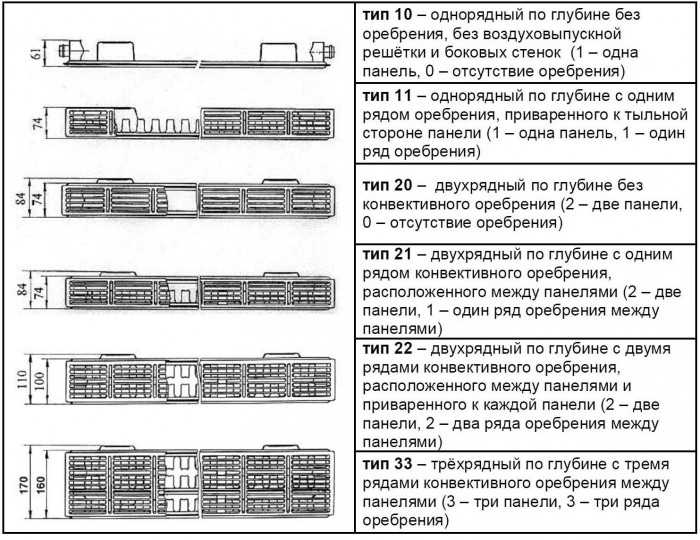
Determining power
The power of steel panel radiators must be determined based on the heat loss of the room in which they will be installed. For apartments located in standard houses, we can proceed from SNiP standards, which normalize the required amount of heat per 1 m 3 of heated area:
- Premises in brick buildings require 34W per 1m3.
- For panel houses 1m3 consumes 41W.
Based on these standards, you determine how much heat is required to heat each room.
For example, a room in panel house 3.2m*3.5m, ceiling height 3m. Let's calculate the volume 3.2 * 3.5 * 3 = 33.6 m 3 . Multiplying by the norm according to SNiP for panel houses we get: 33.6 * 41 = 1377.6 W.
SNiP standards are indicated for average climate zone. For the rest, there are corresponding coefficients depending on average winter temperatures:
- -10 o C and above - 0.7
- -15 o C - 0.9
- -20 o C - 1.1
- -25 o C - 1.3
- -30 o C - 1.5
Correction of heat losses is also necessary depending on the number of external walls, because it is clear that the more such walls, the more heat goes through them. Therefore, we take them into account: if one wall goes outside, the coefficient is 1.1, if there are two, we multiply by 1.2, if there are three, then we increase by 1.3.
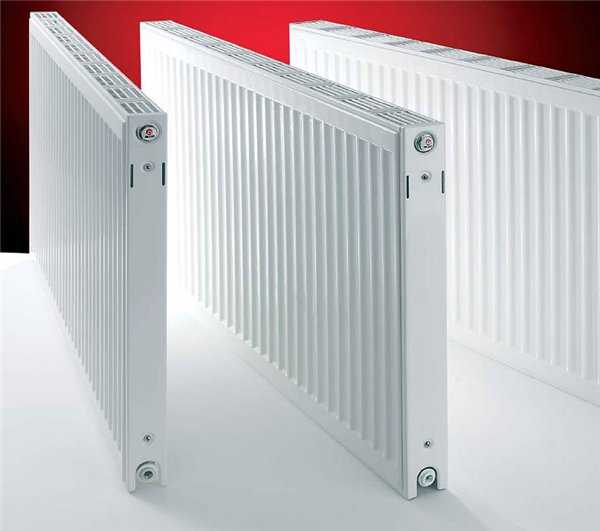
Let's make adjustments for our example. Let the average winter temperature in the region be -25 o C, there are two external walls. It turns out: 1378W*1.3*1.2=2149.68W, rounded up to 2150W.
Let's use this figure as an example. Provided that the insulation of the house and windows is average, the found figure is quite accurate.
Calculation of Kermi radiators
Before determining the power, you need to decide on the brand of steel panel batteries. Naturally, you can trust leaders. German steel radiators Kermi are practically unrivaled today. So we calculate the power using the tables of this manufacturer.
Let's decide to install one of the new Kermi Therm X2 Plan models. Using the table, which shows the capacities of all available models, we find the suitable values. You should not look for an exact match; look for a value that is slightly larger than the calculated one (in heating engineering it is better to have at least a small reserve “just in case”). In the table, the options suitable for our case are marked with red squares. Let the height of 505mm be more acceptable for us (indicated at the top of the table). More attractive than others are the shorter (1005mm) panel radiators of type 33. If you need even shorter ones, you can pay attention to models with a height of 605mm.

Table for calculating the thermal power of Kermi steel radiators (click to enlarge size)
Recalculation of panel radiator power depending on temperature conditions
But the values in this table are valid for a system with parameters 75/65/20 (supply temperature 70 o C, return temperature 65 o C, room temperature is maintained at 20 o C). Based on these values, the temperature delta is calculated: (75+65)/2-20=50 o C.
If your system parameters are different, recalculation is necessary. For such cases, Kermi has compiled a table with correction factors.
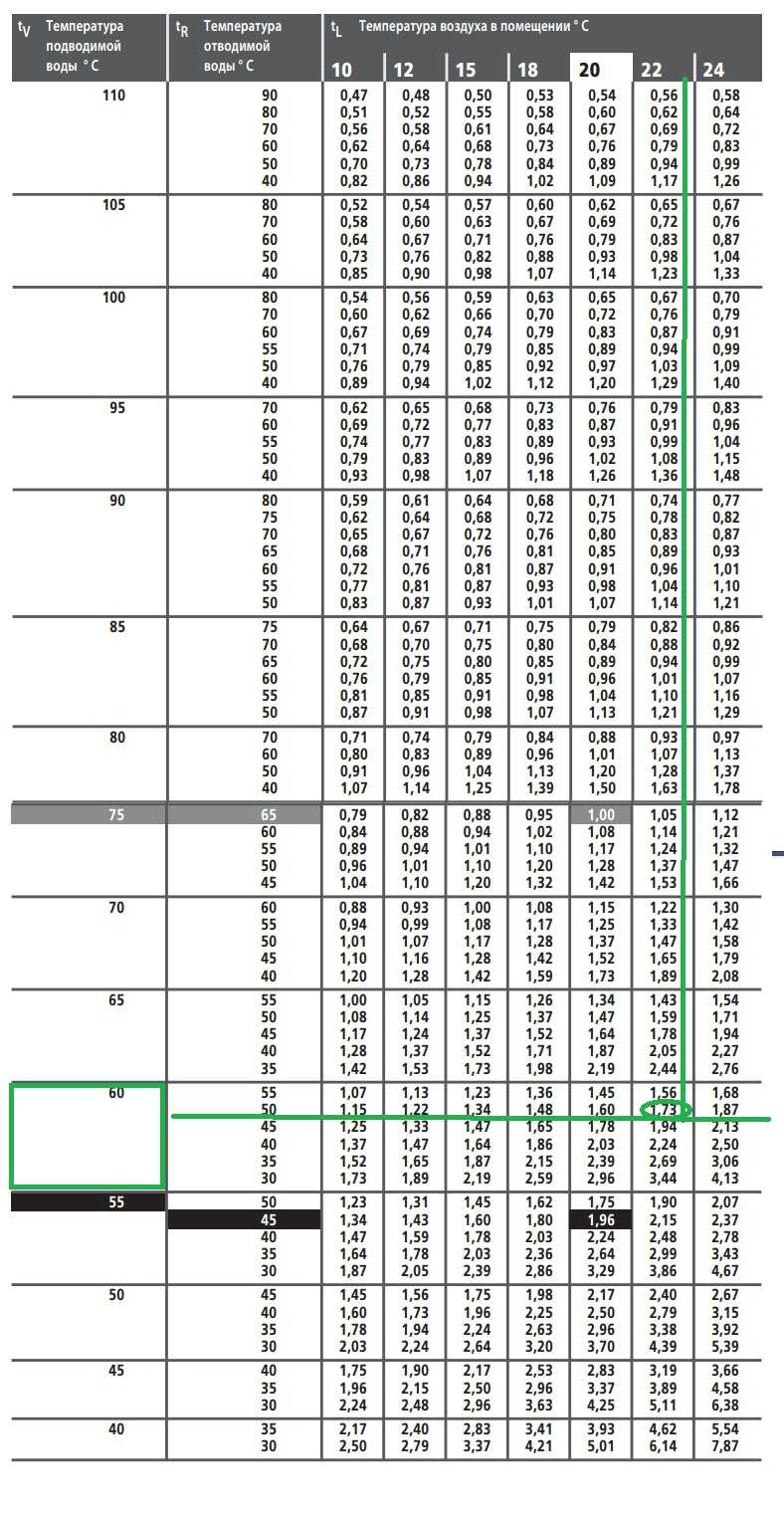
Conversion table depending on heating system temperatures (click to enlarge)
Let us assume a low-temperature system with parameters 60/50/22 (supply temperature 60 o C, return temperature 50 o C, room temperature is maintained at 22 o C). We calculate the temperature delta: (60+50)/2-22=33 o C. We find a line in the table with the temperature of the supplied water, then with the temperature of the discharge water and reach the room temperature value (22 o C in our case). This cell has a coefficient of 1.73 (marked in green).
We multiply the calculated amount of heat loss for our room by it: 2150W*1.73=3719.5W. Now we are looking suitable options in the power table for this case (marked in green). The choice is more modest, but radiators are also required much more powerful.
Here is the entire method for determining the power of panel radiators. Using it you can choose steel panel batteries for any room and any system.
Results
To calculate the power of panel radiators, you need to know the heat loss of the room, the company whose products you want to buy, and the parameters of your heating system (supply temperature, return temperature and room temperature). Using this data and power tables, you can determine the models that meet your conditions. Then from these options choose the one that best suits the parameters (height/length/depth). That's the whole technique.
Replacing one heating device by specialists, it will cost from 2000 rubles. The exact cost will depend on the complexity and volume additional work, if they are needed.
In this article we will look at an example of selection and fully equipped steel radiators heating KERMI.
To simplify the procedure for selecting heating batteries, we will divide them into two main groups:
- BOTTOM connection(FKV);
- SIDE connection(FKO).
The difference in these connection groups lies in the supply of heating pipes, which greatly affects their appearance, for the presence of a built-in thermostat in a radiator with a side connection, and of course determines the cost of the batteries.
After you have chosen the radiator according to the type of connection, you need to select the length and height of the kermi battery. As a rule, Kermi radiators are installed under a window - this creates additional comfort in the house (but if necessary, KERMI radiators can be installed on any other wall).
Therefore, we calculate heating radiators along the length of the entire window sill, and in height, the Kermi radiator should retreat to a distance of 10 - 13 cm from the finished floor and the same from the window sill!!!
Now the time has come Difficult choice– this is the type of radiator or its depth. This characteristic greatly affects the heat transfer of the heating radiator, and if you choose incorrectly this value, then you will either spend extra money, or, worse, you will freeze during the heating season, because the radiator power will not be enough to heat the room.
If you are confident in your abilities, you can choose your own kermi radiators for your home best prices on heating radiators, you can also always order a free selection of radiators in our store (subject to purchasing these products in our store).
After we have chosen the standard sizes, we will find out what is required for installation. IN standard set KERMI connections already include wall mounts, a Mayevsky valve (air vent), plugs (for lateral connection). So the manufacturer has prudently provided everything in the kit to connect the heating radiator.
To install radiators on the floor, you will have to additionally purchase legs for.
When you have installed the heating batteries, you need to connect the heating battery to the heating system using shut-off valves. You also need to understand how the heating pipes will approach the radiators (inside the walls or outside). For this, there are two options for fittings: lateral (when the pipes are built into the walls) and straight (when the pipes are laid outside the walls). To add additional external aesthetics, you can use nickel-plated copper tubes when installing heating radiators.
Calculation of heating radiators
We did the calculations for the heating radiators ourselves.
Formula taking into account area |
|
Power calculation formula steel device heating based on area: P = V x 40 + heat loss due to windows + heat loss due to outer door
|
|
Example: The room is 3x5 meters, with a height of 2.7 meters, with one window and one door. P = (3 x 5 x 2.7) x40 +100 +150 = 1870 W Using these calculations, you can find out what the heat transfer from the heating device will be.to ensure sufficient heating of a given area. |
|
Important!
|
- Kermi radiator 11 5 05 (547 watt) - 2 pcs.
- Kermi radiator 11 5 10 (1147 watt) - 1 pc.
Bedroom 13.1 m2 has one window, but for uniform heating of the room we recommend installing two radiators:
- Kermi radiator 11 5 09 (1032 watt) - 1 pc.
Bedroom 11.1 m2 has one window but for uniform heating of the room, we recommend installing two radiators:
- Kermi radiator 11 5 04 (459 watt) - 1 pc.
- Kermi radiator 11 5 07 (803 watt) - 1 pc.
Dressing room 5.6 m2 has one window:
- Kermi radiator 11 5 06 (688 watt) - 1 pc.
Bathroom 4.6 m2:
- Kermi radiator 11 5 05 (547 watt) - 1 pc.
For the hall We did not provide a choice of radiators, because there are a huge number of options for standard sizes and placement options.
After we have made a selection of KERMI heating radiators for the premises you need, we can look at an example. We took as an example an arbitrary plan of one floor. All calculations of heating radiators are made taking into account possible heat loss at home, so the normal heat transfer margin is from 10% to 15%. But the installation of heating radiators does not end only with the purchase of batteries; you also need to connect to the heating system. To do this, you will need to purchase some additional items:
1. Connection group (multiflex). This element has connecting dimensions: 3/4 union nut (for connection to a radiator) and 3/4 external thread (for installation to a heating system). The kit also includes two conical inserts.
2. Thermostatic head (has many different names). It serves to regulate the temperature of the heating radiators in order to maintain a comfortable temperature regime indoors.
3. Fitting with a 3/4 union nut for connecting the heating pipe to the connection group, purchased together with the pipes. For polypropylene pipes You should additionally purchase two cone inserts.
Conclusion: for one steel heating radiator, you additionally need to purchase a connection group of 1 piece, a thermostatic head of 1 piece (purchased by you at will, the heating battery can also work without it), a fitting with a 3/4 union nut 2 pieces (usually purchased together with pipes - one fitting goes for the pipe with coolant supply, the second fitting goes for the pipe with coolant discharge from the radiator).
1. Manual valve. It has connecting dimensions of 1/2 external thread (for connection to a heating radiator), 1/2 internal thread (for installation to the heating system), and is a shut-off valve for the flow of coolant into the radiator.
2. Thermostatic valve. It is a complete analogue of a manually controlled valve, but allows you to install a thermostatic head for convenient adjustment of the radiator temperature.
3. A check valve with manual control, has connecting dimensions of 1/2 external thread (for connection to a heating radiator), 1/2 internal thread (for installation to a heating system), serves as a shut-off valve for removing coolant from the heating battery.
4. Fitting with external thread 1/2 for connecting the heating pipe to the shut-off valve, purchased together with the pipes.
Conclusion : for one radiator with a side connection, you need to additionally purchase a manually operated valve 1 pc (or a thermostatic valve instead), a manually operated check valve 1 pc, a fitting with a 1/2 male thread (purchased along with the pipes).
Correctly performed calculation of heating radiators is very important, but it is also equally important to fully and correctly equip them. Our specialists will always help you in this difficult matter. We will always be glad to see you!
The heating problem in our latitudes is much more acute than, for example, in Europe, with its mild climate and warm winters. In Russia, a significant part of the territory is under the rule of winter for up to 9 months a year. Therefore, it is very important to pay sufficient attention to the selection of heating systems and, in particular, to the calculation of the power of heating radiators.
Unlike, where only the area is taken into account, the power of heating radiators is calculated according to a different scheme. In this case, you should also take into account the height of the ceilings, that is, the total volume of the room in which it is planned to install or replace the heating system. However, do not be afraid, because in the end the entire calculation is based on elementary formulas, which will not be difficult to cope with. Radiators will heat the room thanks to convection, that is, air circulation in the room. Heated air rises and displaces cold air. So in this article you will get almost the simplest calculation of the power of heating radiators
For example, let's take a room with an area of 15 square meters and with ceilings 3 meters high. Thus, the volume of air to be heated by our future heating system will be:
V=15x3=45 cubic metersNext, we calculate the power that will be required to heat a room of a given volume. In our case - 45 cubic meters. To do this, you need to multiply the volume of the room by the power required to heat one cubic meter air in this region. For Asia, the Caucasus it is 45 W, for middle zone 50 W, for the north about 60 W. As an example, let's take a power of 45W and then we get:
45×45=2025 W - power required to heat a room with a cubic capacity of 45 meters
Selecting a radiator based on calculation
Steel radiators

Let's leave the comparison out of the equation various types heating radiators and note only the nuances that you need to have an idea about when choosing a radiator for your heating system.
In the case of calculating the power of steel heating radiators, everything is simple. There is the necessary power for an already known room - 2025 watts. In this case, look at the table and look for steel batteries that produce the required number of watts. Such tables are easy to find on the websites of manufacturers and sellers of similar products.
Here is an example of such a table:

The table indicates the type of radiator; in this example, we will take type 22, as one of the most popular and quite worthy in terms of its consumer qualities. And a 600x1400 radiator suits us perfectly. The power of the heating radiator will be 2015 W. But it’s better to take a little more than a little less power
Aluminum and bimetallic radiators
![]()
In this case, there is one important difference in calculating the power of radiators. Aluminum and bimetallic radiators often sold in sections. And the capacity in tables and catalogs is indicated for one section. Then it is necessary to divide the power required to heat a given room by the power of one section of such a radiator, for example:
2025/150 = 14 (rounded to whole numbers)And we got the required number of sections of such a radiator for a room with a volume of 45 cubic meters.
Don't overdo it!
It should also be noted that 14-15 sections for one radiator is the maximum. Installing radiators of 20 or more sections is ineffective. In this case, you should split the number of sections in half and install 2 radiators of 10 sections each. For example, place 1 radiator near the window, and the other near the entrance to the room or on the opposite wall. In general, it's up to you.
It's the same story with steel radiators. If the room is large enough and the radiator is too large, it is better to install two smaller ones, but with the same total power.
If a room of the same volume has 2 or more windows, then good decision There will be a radiator installed under each of the windows. In case of sectional radiators everything is quite simple.
14/2=7 sections under each window for a room of the same volumeBut, since such radiators are usually sold in 10 sections, it is better to take an even number, for example 8. A supply of 1 section will not be superfluous in case of severe frosts. This will not change the power much, but the heating inertia of the radiators will decrease. This can be useful if cold air often enters the room. For example, if this office space, which customers often visit. In such cases, radiators will heat the air a little faster.
What to do after the calculation?
After calculating the power of heating radiators for all rooms, it will be necessary to select a pipeline by diameter and taps. Number of radiators, length of pipes, number of taps for radiators. Calculate the volume of the entire system and select a suitable boiler for it.
For humans, home is often associated with warmth and comfort. And in order for the house to be warm, it is necessary to pay due attention to its heating system. Modern manufacturers use Newest technologies for the production of various elements of heating systems. However, without proper planning of such a system, these technologies may be useless for certain premises.
Despite the emergence of new types of devices, steel radiators remain attractive to many users. Let's carefully study their advantages and disadvantages, and also give examples. correct application. In addition, we present an algorithm of actions that will help anyone quickly and accurately calculate the parameters of a radiator for a specific room.
Technical characteristics of heating batteries made of steel
Old models of radiators of this type consisted of a pipe to which plates were welded vertically. To improve aesthetic parameters, this structure was covered with a tin box. Today, such solutions are rarely used. More often, the structure is created from two steel plates, in which channel profiles are created by stamping. They are welded and covered with protective and decorative layers.
It is important for the average consumer to know what similar products he can use so that the calculation is accurate. That is why we further use comparative specifications. At the beginning Let's list the advantages of steel radiators:
- Fast heating and good thermal conductivity. These parameters confirm the suitability for installation of such batteries in automated systems heating systems that regulate the operation of the boiler depending on the readings of several temperature sensors.
- Good compatibility with various metals. These devices can be connected to copper and other pipelines without restrictions.
- Lightness of one section. With a power of 100 W, the product will weigh no more than one and a half kg.
- His small sizes are also beneficial. It won't be hard to find appropriate place for installation.
- Small internal volume. It will come in handy in a private home, where the thrifty owner accurately calculates the amount of coolant he needs.
- Not high cost.
To maintain objectivity, here is a list of restrictions:
- Relatively small sizes of working channels. In some cases, mechanical impurities can get stuck in them.
- Low resistance to oxidative chemical reactions.
- Low mechanical strength connections and relatively low resistance to water hammer.
- Integrity of design. In such devices it is impossible to change the dimensions by adding or detaching a section. Thus, the possibility of making an accurate calculation taking into account the size of the area and height of a certain room is reduced.
This table provides data for general comparison with other types of radiators:
|
Parameters/type of heating device |
Cast iron |
Aluminum |
Bimetallic |
Steel |
|
Pressure in the heating main (max.), bar. |
||||
|
Section power (comparable solid product), W |
||||
|
Permissible coolant temperature (max.), gr. Celsius |
Calculation of heating radiators made of steel
Here is a simple algorithm that will help you independently calculate how much power the metal sections will need to heat a room of a certain area:
- Let's assume that the dimensions of the room are as follows (length X width X height) in m: 5 X 3 X 2.8. Its volume will be: 5*3*2.8=42 cubic meters.
- If energy-saving technologies are not used (special wall insulation, multi-chamber double-glazed windows, etc.), then according to current standards per 1 cubic meter. m of living space with windows facing south, 40 W will be enough. This figure is suitable for calculating the heating system of a house located in the middle climatic zone of Russia, for example, in the Moscow region. To work with a room of this area, you will need the following total thermal power of the section: 42*40=1680 W.
- In order not to experience difficulties in severe frosts, it is better to increase the nominal value to 20%. Total: 1680*1.2=2016. IN model range manufacturer, we find a suitable product, rounded by power - 2.0 kW.
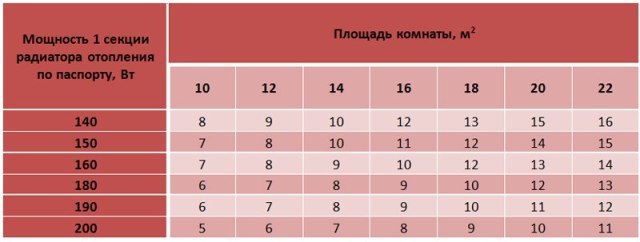
On some specialized websites of radiator sellers and manufacturers, such section calculations can be performed automatically. To do this, it is proposed to fill out a table or form on the following points:
- room dimensions (area and height);
- building type;
- residential/technical premises;
- type of boiler or other heat source;
- number of external walls;
- presence/absence of double-glazed windows;
- the level of internal temperature that the user prefers.
Features of application and increase in heating efficiency
Low battery response made of steel allows these devices to be successfully used in modern individual heating systems. Such equipment is complemented by sensors that monitor the temperature of the air and coolant at different points. Depending on the data received, a decision is made quickly to change the settings. As a result, the level of comfort required by the user is created and maintained without extra costs energy resources.
Precisely sized batteries, the characteristics of one section will be useful in any case. But, if work is not done to insulate the house, then all efforts will be in vain. Corresponding losses through walls and defects window openings will destroy all theoretical benefits. That is why, at the stage of selecting suitable radiators, insulation deficiencies, technical imperfections of boilers and other heating equipment should be checked and eliminated.
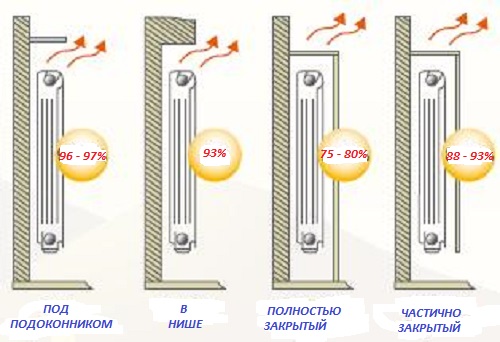
The power of steel radiators indicated in the technical data sheet- These are indicative data. These opportunities will not always be fully used. If you produce side connection device, then losses can amount to 8-10%. The bottom connection is even less effective. In this case, the deterioration standard indicator can reach a value of 18-20%. Meanwhile, if laying pipes only in a screed is permissible, then you will have to use the latter option. To completely fill the batteries, you can try to increase the pressure in the system using a special pump that provides forced circulation coolant.
The data provided confirm that each calculation of a heating project must be made individually. You will have to take into account the features of the following components: equipment, building, operating mode.
